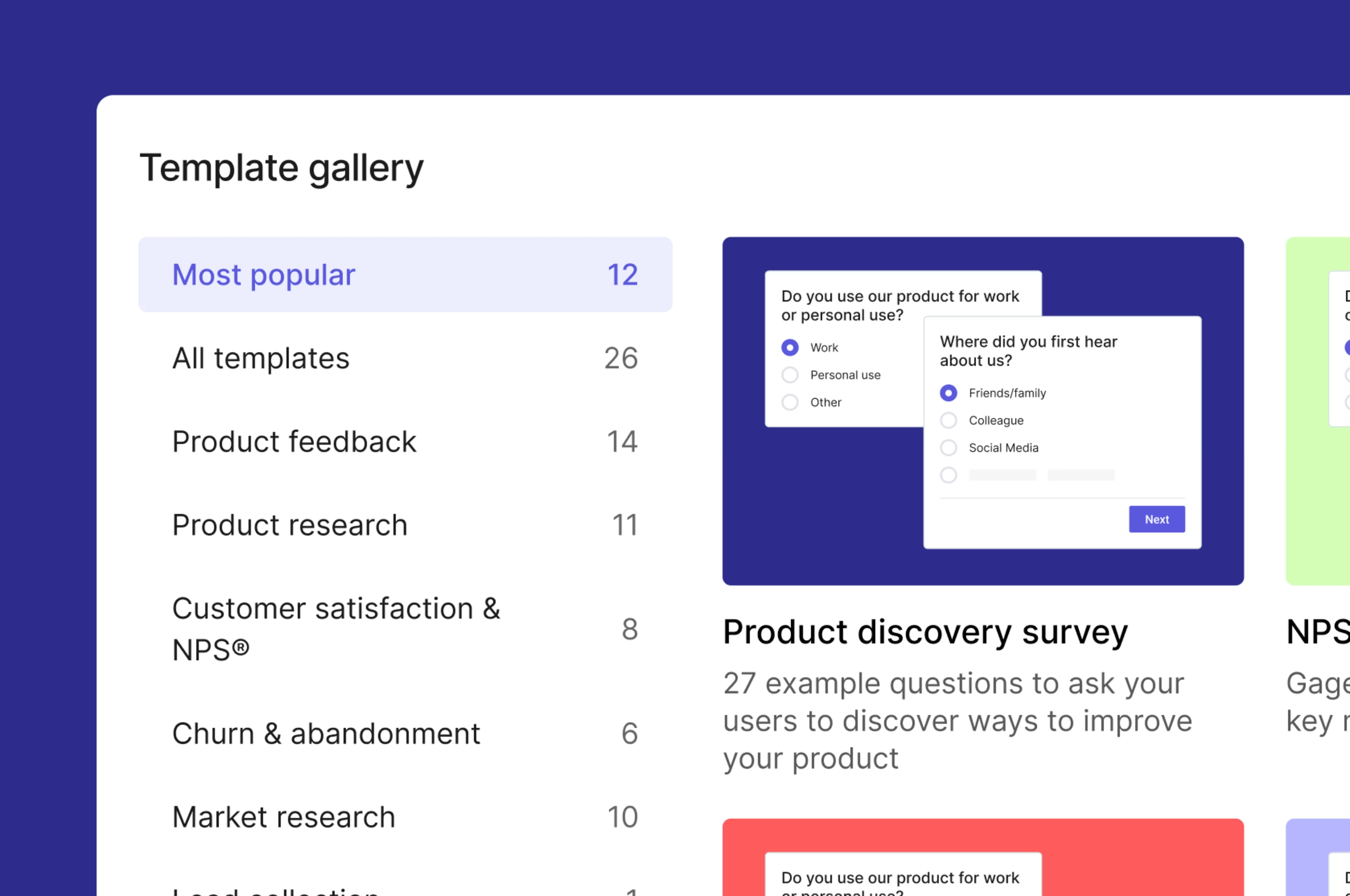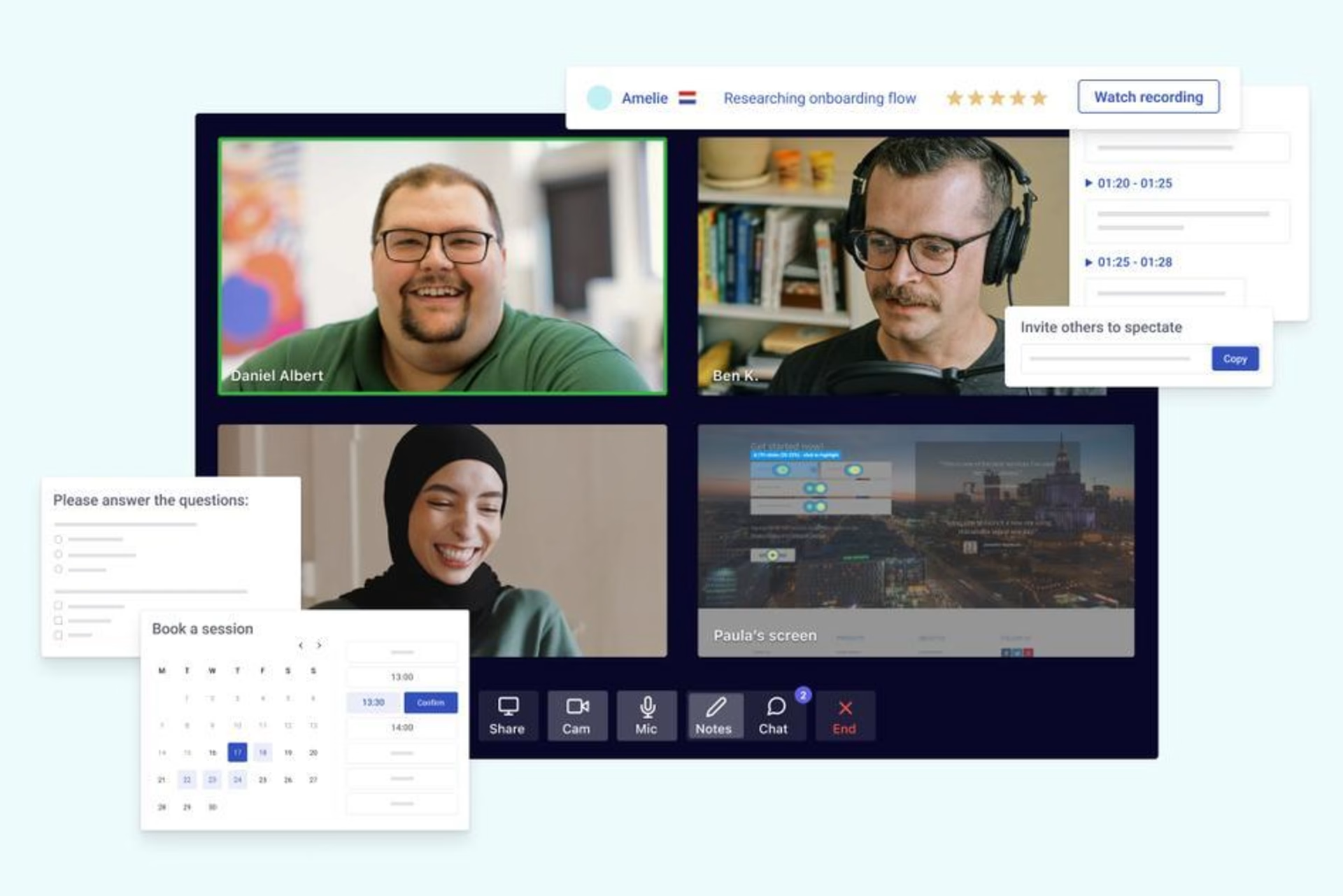Have you read a bad online review of your business or product recently? Then you might be tempted to disagree with us—but this is the golden age for capturing customer feedback.
Today, customers looking for a place to rave (or vent) about your business are spoiled for choice—from comments and review sections to forums, chatrooms, blogs, and social media platforms.
If you want to (and you should), you can hear the customer's voice louder and clearer than ever before. But only if you know where—and how—to find it.
In this chapter of our guide, we cover 6 of the most effective methods for collecting voice-of-the-customer (VoC) data.
6 effective methods to collect voice-of-the-customer data
We explained why collecting VoC data is so important for your business in Chapter 1, but let’s do a quick recap. VoC data helps you
Understand customer needs, pain points, and expectations, so you can meet (and exceed) them
Improve product elements and features that frustrate your customers
Replicate product elements and campaigns that delight customers
Get product development ideas for new features by paying attention to customer requests and complaints
Show customers you value their opinions and business, increasing customer lifetime value (CLTV) and loyalty and reducing churn
There are two main types of VoC feedback your business needs to collect.
Solicited customer feedback that you request directly from your customers: these include surveys, feedback forms, customer interviews, and focus groups
Unsolicited customer feedback that comes indirectly from your customers without prior request. These include customer service feedback, social media posts, online reviews, and user behavior on websites, apps, and other digital products
Let’s run through 6 of the main voice-of-customer data collection techniques in more detail.
1. Surveys
Surveys involve asking a group of customers a series of questions and analyzing their responses to get an overall sense of how your user base feels about your brand, products, services, and customer experience (CX).
Use surveys to get qualitative and quantitative insights into every aspect of your CX:
Quantitative (or numerical) data comes from asking questions like, “On a scale of 1–10, how happy are you with our checkout experience?
Qualitative data comes from asking questions like, “How would you describe your overall experience with our brand?
The most effective way to run surveys is by deploying them within your digital journeys, setting them up to trigger (either in-screen, in-the-moment, or via another channel, ex: email, SMS) when users perform important actions, such as
Making a purchase (particularly for the first time)
Onboarding onto your app
Using a new product feature for the first time
Canceling their subscription to your service
How Contentsquare’s VoC helps
Use Contentsquare’s Voice of Customer to set up online surveys that appear at your key user journey touchpoints in seconds. Simply select an option from our 40+ customizable templates—or tell our AI assistant what your survey goal is, and it’ll set it up for you.
Once users start responding to your survey, AI-generated summary reports give you an automatic overview of key opportunities and issues raised.
Plus, you can automatically tag text responses by topics and keywords to track user sentiment and understand how frequent—and impactful—any issues are.
![[Visual] Exit-intent survey](http://images.ctfassets.net/gwbpo1m641r7/70LxdbnLg3vHHjjMfZjfmb/ae68013aad3713169bfcac7b7ab1c795/image3.png?w=1920&q=100&fit=fill&fm=avif)
Surveys are great for tracking customer satisfaction metrics, most prominently
Net Promoter Score® (NPS®) tracks customer loyalty and satisfaction by asking users, “On a scale of 0–10, how likely are you to recommend us?” Detractors rate from 0–6, passives rate from 7–8, and promoters rate from 9–10. Subtract the percentage of detractors from the percentage of promoters to get your NPS score.
Customer satisfaction (CSAT) measures your customers’ overall satisfaction with your service on a scale of 1–5. Take the total number of 4 and 5 ratings, divide it by the number of responses and multiply by 100.
Customer effort score (CES) measures how much effort customers have to make to use your product or service, find information, or resolve an issue. To measure CES, ask a question like ‘How easy was it to solve X problem with us today?’, give them a scale of 1–5 to choose from, with 1 being ‘Not easy at all’ and 5 being ‘Very easy’—and calculate as with CSAT.
How Contentsquare’s VoC helps
Set up NPS surveys with Contentsquare to trigger after important events, such as when a user completes a purchase or accesses support.
Negative feedback alerts you to improvements you need to make, while positive feedback tells you which ideas to prioritize to boost customer retention.
Use Contentsquare to
Compare sentiment across segments, and target specific segments to get highly relevant feedback
Integrate surveys within your workflows using built-in automation
Watch session recordings with the Session Replay tool to get to the bottom of negative feedback
Be warned: you can all too easily overload on surveys, inadvertently interrupting and ruining the user experience—just think about how many times you’ve been annoyed by a pop-up.
That’s why you need to be mindful of where and when you’re positioning surveys within your customer journey. You also need to ask the right questions. Check out our post on how to set up surveys in Chapter 4.
💡Pro tip: use Contentsquare’s digital experience analytics tools like Zone-Based Heatmaps and Customer Journey Analysis to track how users are responding to being asked to fill in a survey, answering questions like
Are they reacting eagerly or angrily?
How does their reaction change if the pop-up box is made slightly smaller?
When they only partially complete the survey, at what point do they give up, and what do they do afterward?
It’s best to collect feedback from customers after they’ve made a purchase, used your product or service, or contacted your support team—when they’re most likely to feel they can make an informed judgment of your product, service, or business.
You can even survey your customers as they’re leaving your website (without converting). Use exit-intent surveys to trigger a pop-up that asks visitors why they’re leaving and what you could do to improve your service.
Not only does this help you understand what’s causing visitors to leave, but by demonstrating you care about their feelings, you might even stop them from abandoning your website entirely.
2. Feedback buttons
Feedback buttons (or widgets) are clickable elements within your digital experiences that enable users to let you know what they’re thinking.
This could mean scoring their satisfaction levels from 1–10 or leaving you textual feedback.
Sounds similar to surveys, right?
The difference is that feedback buttons, unlike surveys, aren’t triggered by actions, but are (wherever you choose to include them) always-visible elements that customers choose to engage with.
Feedback buttons are highly effective for collecting customer sentiments that surveys—which should be used sparingly—might miss.

How Contentsquare’s VoC helps 💡
Our platform’s Digital Experience Monitoring constantly scans your experiences for technical issues and signs of user frustration—and Voice of Customer gives you further tools for letting customers tell you what’s bugging them.
Use Contentsquare to
Add feedback buttons anywhere on your site, giving users the opportunity to report any bugs or issues they encounter
Investigate the cause behind negative feedback using Digital Experience Monitoring and Session Replay
Quantify the impact of issues on your KPIs with Impact Quantification
![[Visual] Session replay - Triggered recording](http://images.ctfassets.net/gwbpo1m641r7/3x0k1KqlgQqa818JvI8mni/d323e94e4fcf5afeb2fd870577f06d15/Triggered_recording.png?w=3840&q=100&fit=fill&fm=avif)
3. Customer interviews and focus groups
Face-to-face interviews (whether online or in-person) are a great way to gather feedback. They give you more in-depth insights than surveys (which customers may have limited patience for) and help you get to the bottom of how your customers feel about your products, services, and company.
They’re also useful for showing your customers that you really care about their perspective.
However, setting up interviews takes more time and resources than soliciting feedback via a button or widget—unless you’re using Contentsquare, which makes interviewing users quick and easy (more on this below).
You can interview customers individually, but make sure you cover a range of customer types so you get multiple perspectives. One efficient way to do this is to run focus groups, where you bring 8-12 customers together to share their beliefs, opinions, and perceptions.
Ask targeted, open-ended questions for more actionable, focused feedback—and make sure to stay on topic, while letting things flow naturally.
How Contentsquare’s VoC helps 💡
Use Contentsquare to set up user research projects such as customer interviews in less than 10 minutes.
It lets you
Recruit interviewees from a diverse pool of 200,000+ participants from over 130 countries and 25 industries—or from your own user base
Easily create a shortlist of interviewees who match your exact needs, filtering by criteria such as age, gender, location, education, and employment status
Avoid admin headaches with automated scheduling, hosting, recording, and transcription
Highlight key moments in your calls and add notes for your team so they can quickly extract customer insights from interviews

Use Contentsquare’s interview tool to set up chats with subject matter experts and your own users
4. Customer service interactions
Customer service interactions are a great source of feedback, giving you (via your reps) valuable insights into issues with your product and overall customer experience, so you can better meet expectations and reduce churn.
Use conversational intelligence tools like Invoca to apply automated conversation analysis to your customer support recordings to discover trends and identify your most common product issues.
Invoca integrates with Contentsquare, so you can
Tie conversations to individual web sessions, revealing the behavior that led customers to pick up the phone
Identify ‘digital leakage’ points where a customer exits your product to get assistance
You can do the same with your AI-powered live chats. Solutions such as LivePerson comb conversational interactions and turn them into actionable data.
LivePerson also integrates with Contentsquare, meaning you can
Investigate customer complaints raised in conversations using Session Replay
Quantify the impact of live chat interactions on site metrics with Impact Quantification
Trigger chat intercepts via Live Signals when customers experience frustration
💡 Pro tip: one of the best times to solicit feedback from a customer via a survey or feedback form is immediately after they’ve interacted with a customer support agent.
5. Social media
Love it or hate it, social media is great for businesses looking to listen to what their customers have to say—unfiltered.
This can mean ‘listening in’ on what customers are saying, but it can also mean connecting directly with them by joining the conversation on platforms like Twitter, Facebook, LinkedIn, and TikTok.
While you, of course, have to be careful of what you say, having these conversations strengthens your customer relationships—and not just with the people you’re responding to.
There are potentially millions of conversations happening on social media that might be of interest to your business, which means you need something more sophisticated than a search function to keep up with them.
Social media management tools like Sprout Social and Hootsuite feature AI-powered social listening tools that let you track millions of online conversations, search for keywords (such as your brand or product names), and analyze sentiment.
6. Online reviews
Whether glowing or withering, reviews are a goldmine of customer feedback.
It can be daunting (and dispiriting) to read reviews from your customers. But there’s no getting around it: potential buyers read customer reviews—so you should, too.
As with social media, you can either silently read reviews and take notes, or (depending on the platform), you can engage with them, showing appreciation for positive feedback and concern and empathy for negative feedback.
Use a user-generated content (UGC) platform like Bazaarvoice that enables you to monitor and respond to reviews on your retail partner sites—and when integrated with Contentsquare, lets you understand how reviews impact the behavior of your digital customers and your engagement and conversion rates.
7. Website and app behavior
It’s likely that a lot of your customers aren’t ever going to leave you feedback, good or bad.
Does this mean you’re stuck listening to only a vocal minority? Not necessarily.
You can listen to what customers are telling you without putting it into words.
Analyzing customer behavior with digital experience analytics tools like zone-based heatmaps, customer journey analysis, and session replays is a great way to understand how customers are using your website, app, or product, and why they’re behaving that way.
Platforms like Contentsquare help you answer questions about your customers like
How are they making their way through your website?
Where are they clicking and tapping?
Where are they scrolling?
You need feedback to move forward
Your customers can tell you how to create a better brand—if only you have the necessary VoC data collection tools in place to listen to them.
But collecting VoC data is just the start. To turn the mountains of VoC data you collect into brand-bolstering insights, you need to analyze it—with not a little help from machine learning.
No analysis = paralysis. Keep things moving by making a beeline for Chapter 3 of this guide, where we explain how to analyze your freshly collected voice-of-the-customer feedback.

![[Visual] Contentsquare's Content Team](http://images.ctfassets.net/gwbpo1m641r7/3IVEUbRzFIoC9mf5EJ2qHY/f25ccd2131dfd63f5c63b5b92cc4ba20/Copy_of_Copy_of_BLOG-icp-8117438.jpeg?w=1920&q=100&fit=fill&fm=avif)